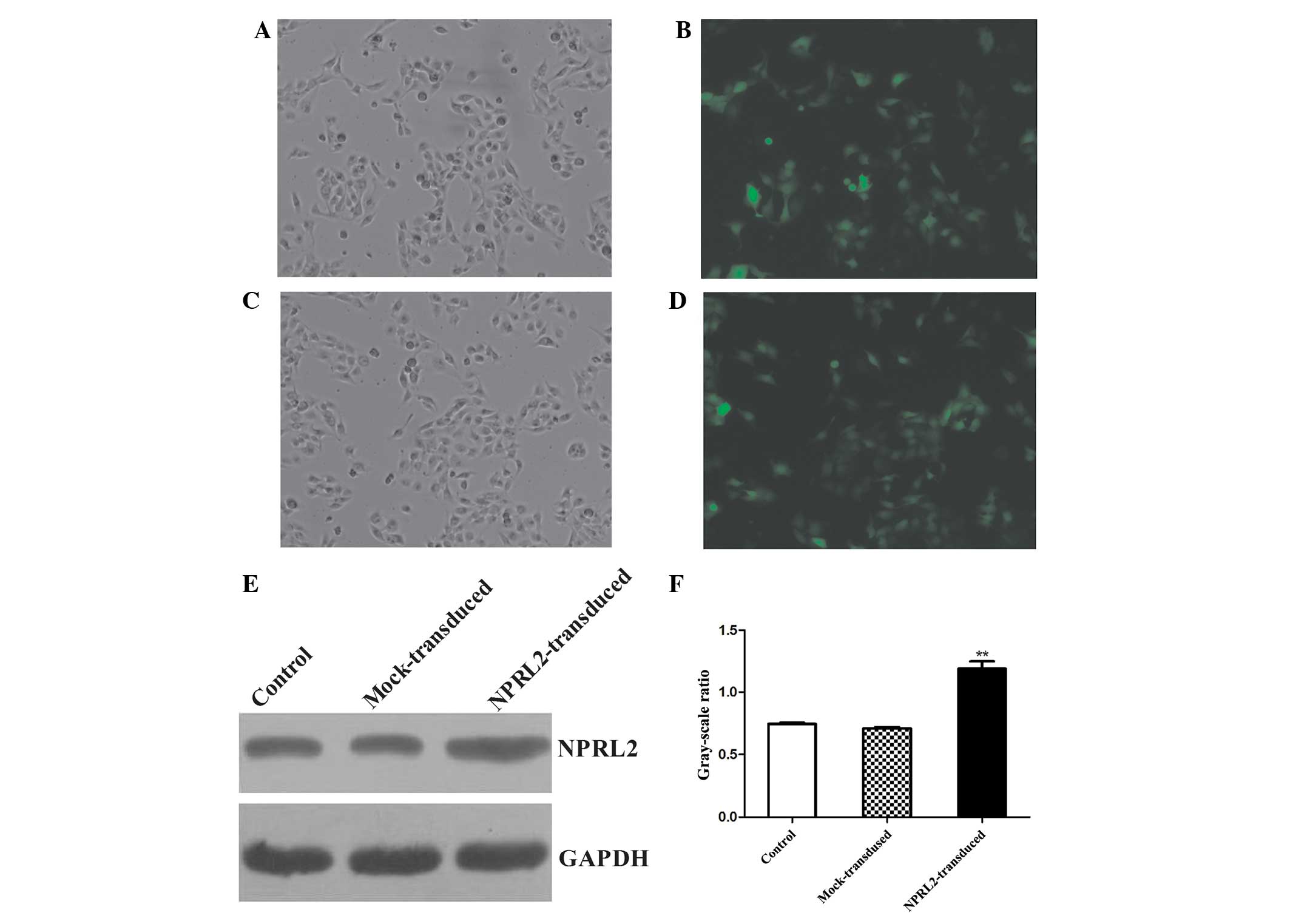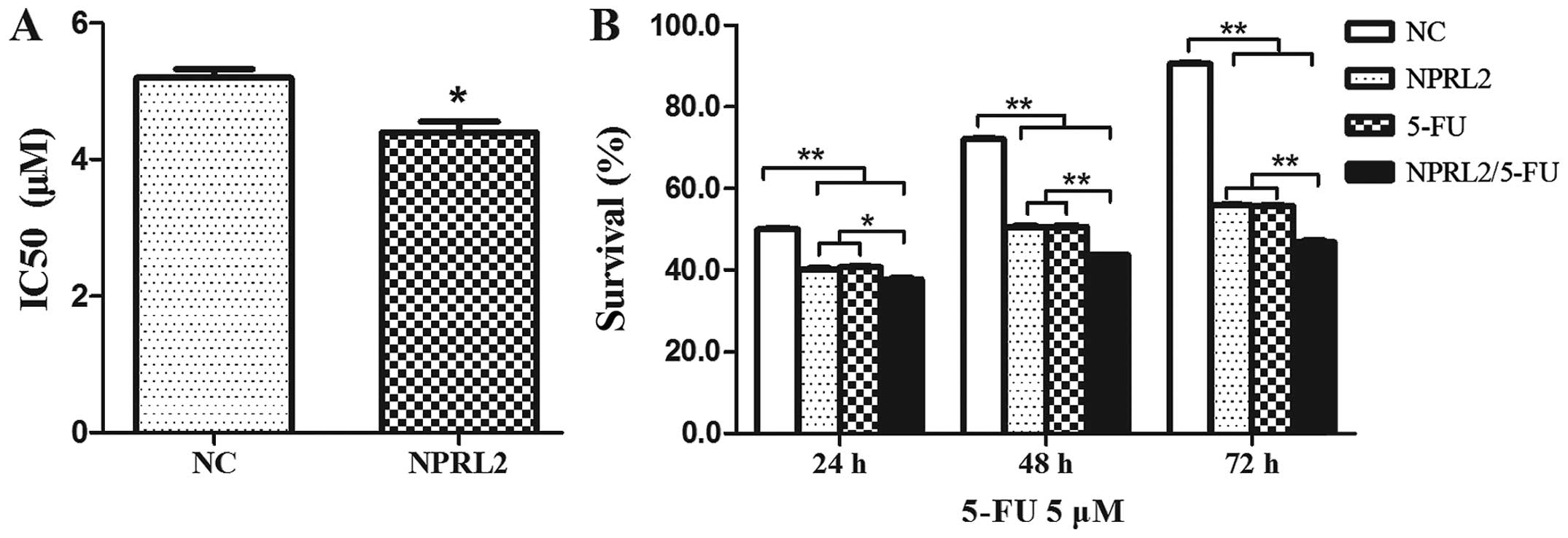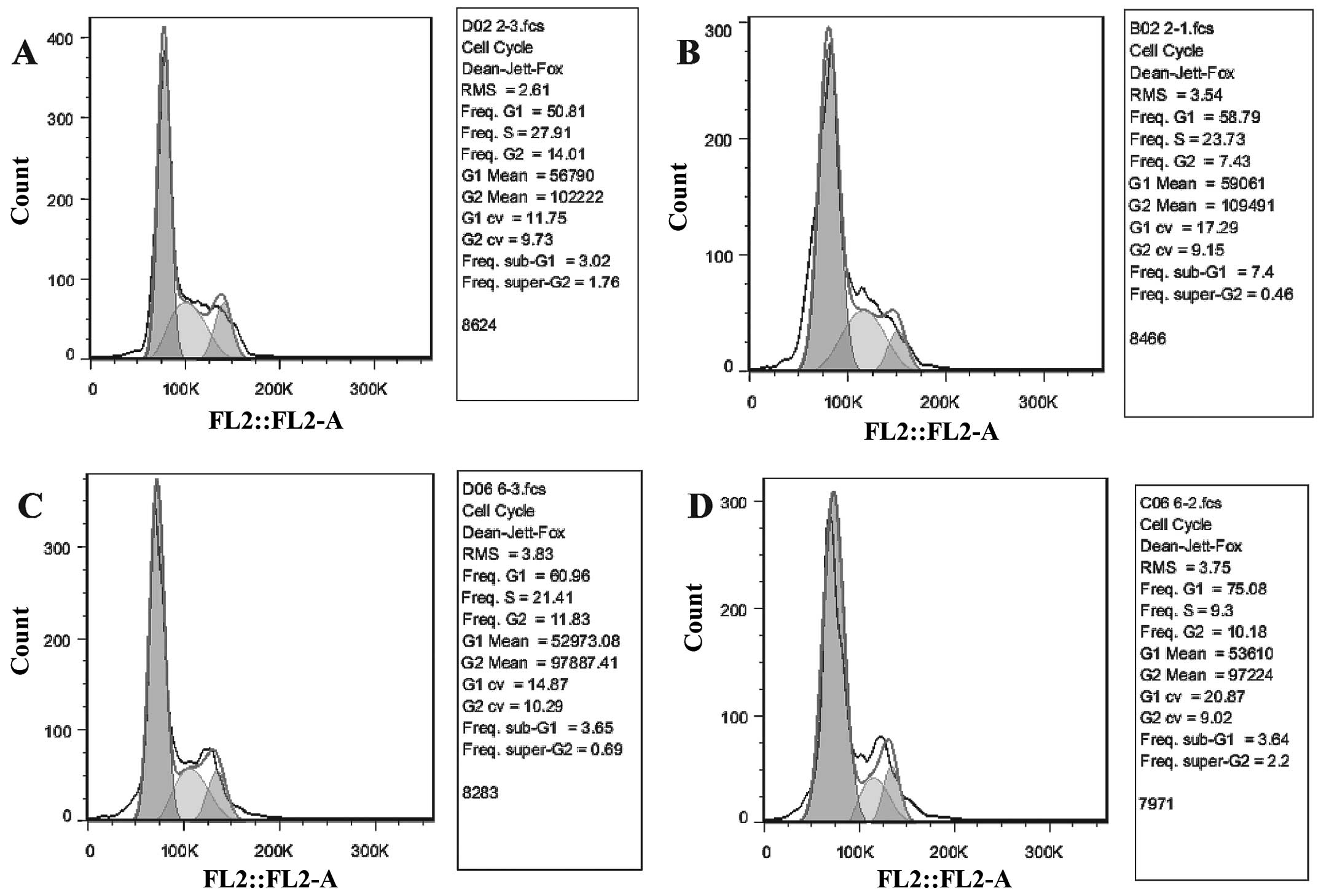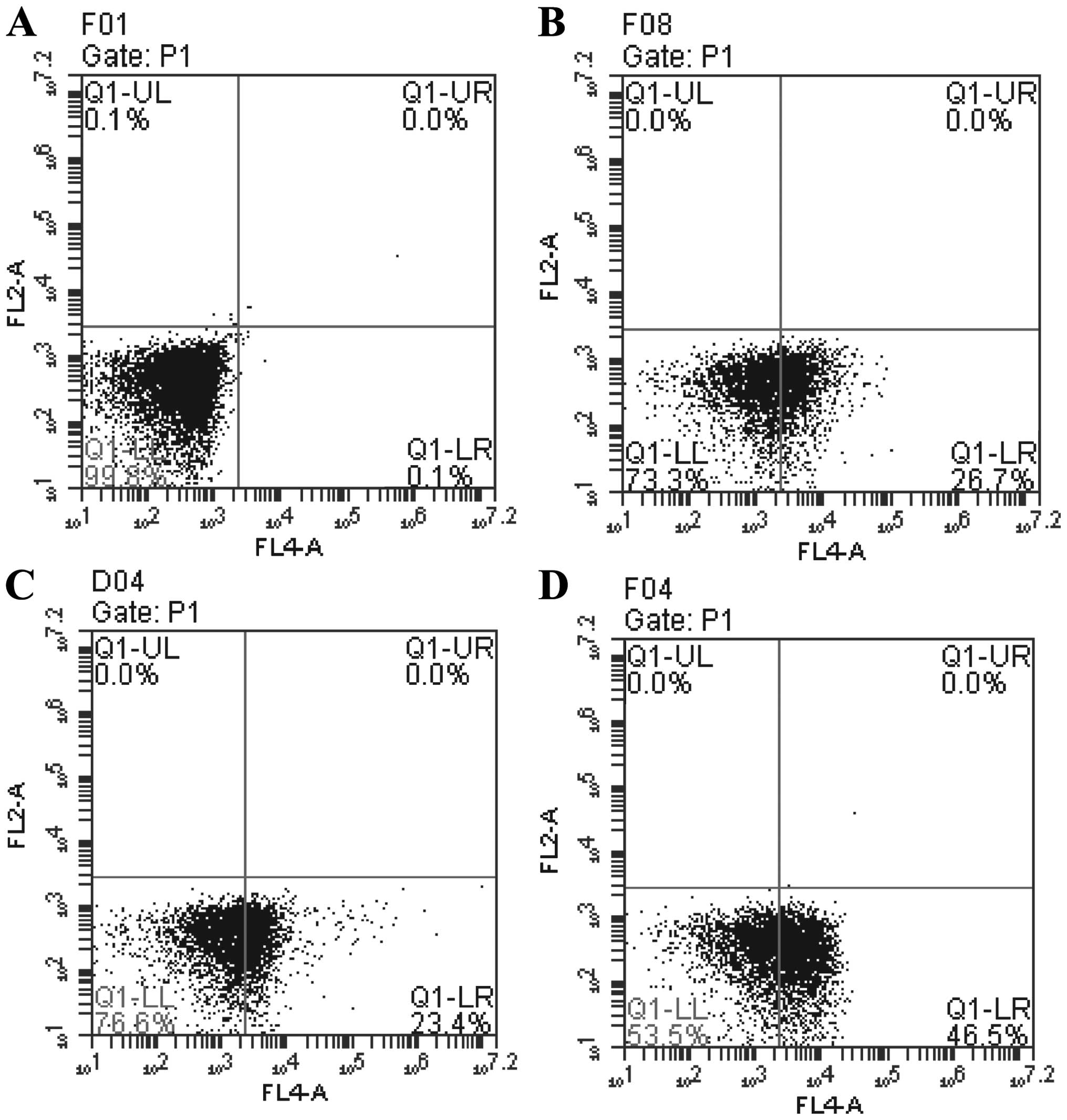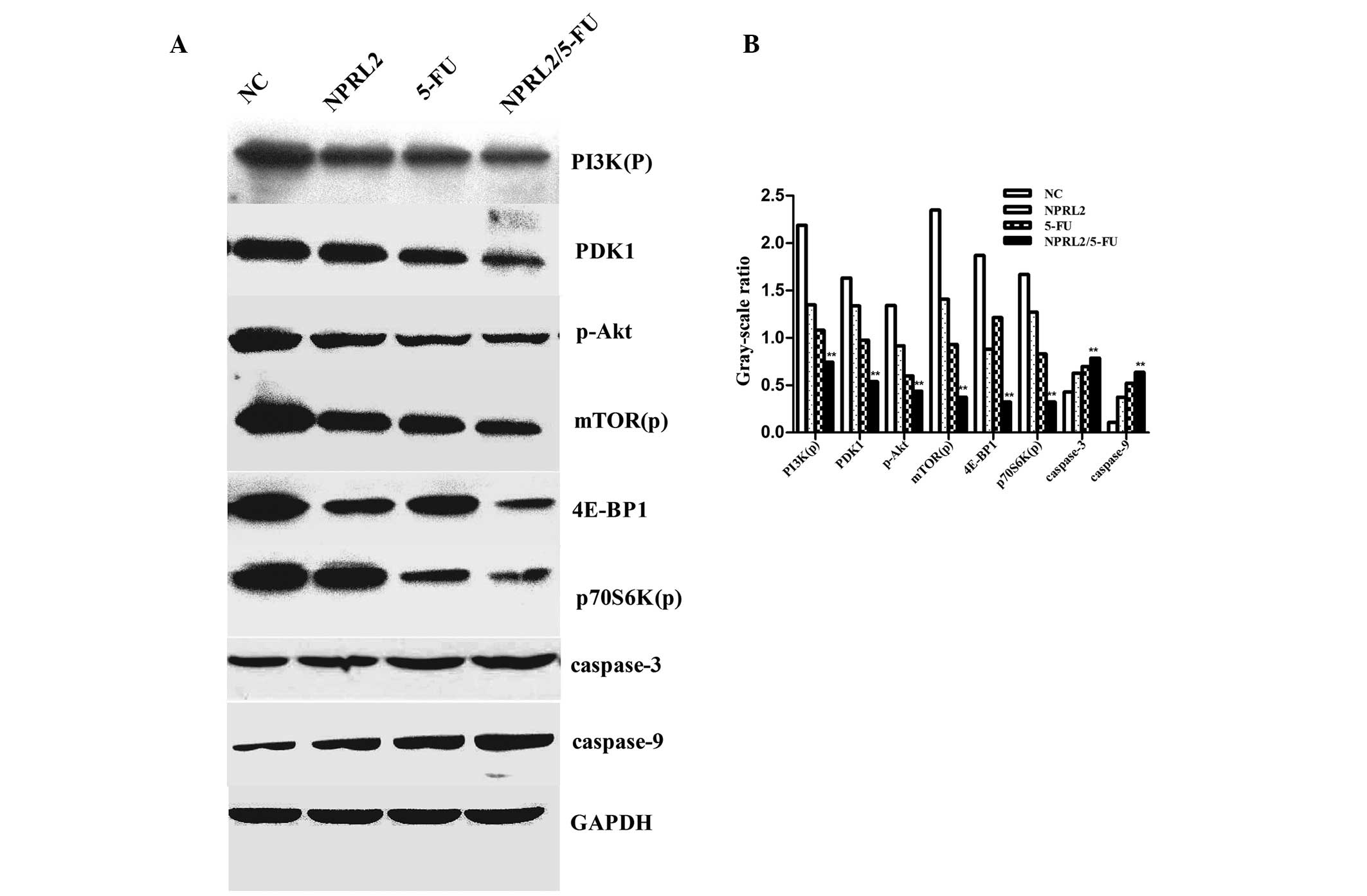|
1
|
Siegel R, Naishadham D and Jemal A: Cancer
statistics, 2012. CA Cancer J Clin. 62:10–29. 2012. View Article : Google Scholar : PubMed/NCBI
|
|
2
|
Patel BB and Majumdar AP: Synergistic role
of curcumin with current therapeutics in colorectal cancer:
Minireview. Nutr Cancer. 61:842–6. 2009. View Article : Google Scholar : PubMed/NCBI
|
|
3
|
Borralho PM, da Silva Moreira IB, Aranha
MM, Albuquerque C and Nobre Leitao C: Inhibition of Fas expression
by RNAi modulates 5-fluorouracilinduced apoptosis in HCT116 cells
expressing wild-type p53. Biochim Biophys Acta. 1772:40–47. 2007.
View Article : Google Scholar : PubMed/NCBI
|
|
4
|
Peters GJ, van Triest B, Backus HH, Kuiper
CM, van der Wilt CL and Pinedo HM: Molecular downstream events and
induction of thymidylate synthase in mutant and wild-type p53 colon
cancer cell lines after treatment with 5-fluorouracil and the
thymidylate synthase inhibitor raltitrexed. Eur J Cancer.
36:916–924. 2000. View Article : Google Scholar : PubMed/NCBI
|
|
5
|
Lerman MI and Minna JD: The 630-kb lung
cancer homozygous deletion region on human chromosome 3p21.3:
Identification and evaluation of the resident candidate tumor
suppressor genes. The International lung cancer chromosome 3p21.3
tumor suppressor gene consortium. Cancer Res. 60:6116–6133.
2000.PubMed/NCBI
|
|
6
|
Wistuba II, Behrens C, Virmani AK, Mele G,
Milchgrub S, Girard L, Fondon JW III, Garner HR, McKay B, Latif F,
et al: High resolution chromosome 3p allelotyping of human lung
cancer and preneoplastic/preinvasive bronchial epithelium reveals
multiple, discontinuous sites of 3p allele loss and three regions
of frequent breakpoints. Cancer Res. 60:1949–1960. 2000.PubMed/NCBI
|
|
7
|
Zabarovsky ER, Lerman MI and Minna JD:
Tumor suppressor genes on chromosome 3p involved in the
pathogenesis of lung and other cancers. Oncogene. 21:6915–6935.
2002. View Article : Google Scholar : PubMed/NCBI
|
|
8
|
Ji L, Nishizaki M, Gao B, Burbee D, Kondo
M, Kamibayashi C, Xu K, Yen N, Atkinson EN, Fang B, et al:
Expression of several genes in the human chromosome 3p21.3
homozygous deletion region by an adenovirus vector results in tumor
suppressor activities in vitro and in vivo. Cancer Res.
62:2715–2720. 2002.PubMed/NCBI
|
|
9
|
Schenk PW, Brok M, Boersma AW, Brandsma
JA, Den Dulk H, Burger H, Stoter G, Brouwer J and Nooter K:
Anticancer drug resistance induced by disruption of the
Saccharomyces cerevisiae NPR2 gene: A novel component involved in
cisplatin- and doxorubicin-provoked cell kill. Mol Pharmacol.
64:259–268. 2003. View Article : Google Scholar : PubMed/NCBI
|
|
10
|
Ueda K, Kawashima H, Ohtani S, Deng WG,
Ravoori M, Bankson J, Gao B, Girard L, Minna JD and Roth JA: The
3p21.3 tumor suppressor NPRL2 plays an important role in
cisplatin-induced resistance in human non-small-cell lung cancer
cells. Cancer Res. 66:9682–9690. 2006. View Article : Google Scholar : PubMed/NCBI
|
|
11
|
Li J, Wang F, Haraldson K, Protopopov A,
Duh FM, Geil L, Kuzmin I, Minna JD, Stanbridge E, Braga E, et al:
Functional characterization of the candidate tumor suppressor gene
NPRL2/G21 located in 3p21.3C. Cancer Res. 64:6438–6443. 2004.
View Article : Google Scholar : PubMed/NCBI
|
|
12
|
Jayachandran G, Ueda K, Wang B, Roth JA
and Ji L: NPRL2 sensitizes human non-small cell lung cancer (NSCLC)
cells to cisplatin treatment by regulating key components in the
DNA repair pathway. PLoS One. 8:e119942010. View Article : Google Scholar
|
|
13
|
Efficacy of adjuvant fluorouracil and
folinic acid in colon cancer. International multicentre pooled
analysis of colon cancer trials (IMPACT) investigators. Lancet.
345:939–944. 1995. View Article : Google Scholar : PubMed/NCBI
|
|
14
|
Johnston PG and Kaye S: Capecitabine: A
novel agent for the treatment of solid tumors. Anticancer Drugs.
12:639–646. 2001. View Article : Google Scholar : PubMed/NCBI
|
|
15
|
Zhou BB and Elledge SJ: The DNA damage
response: Putting checkpoints in perspective. Nature. 408:433–439.
2000. View
Article : Google Scholar : PubMed/NCBI
|
|
16
|
Johnson SM, Gulhati P, Rampy BA, Han Y,
Rychahou PG, Doan HQ, Weiss HL and Evers BM: Novel expression
patterns of PI3K/Akt/mTOR signaling pathway components in
colorectal cancer. J Am Coll Surg. 210:767–776. 2010. View Article : Google Scholar : PubMed/NCBI
|
|
17
|
Maira SM, Voliva C and Garcia-Echeverria
C: Class IA phosphatidylinositol 3-kinase: From their biologic
implication in human cancers to drug discovery. Exp Opin Ther
Targets. 12:223–238. 2008. View Article : Google Scholar
|
|
18
|
Ekstrand AI, Jönsson M, Lindblom A, Borg A
and Nilbert M: Frequent alterations of the PI3K/AKT/mTOR pathways
in hereditary nonpolyposis colorectal cancer. Fam Cancer.
9:125–129. 2010. View Article : Google Scholar : PubMed/NCBI
|
|
19
|
Samuels Y and Ericson K: Oncogenic PI3K
and its role in cancer. Curr Opin Oncol. 18:77–82. 2006. View Article : Google Scholar : PubMed/NCBI
|
|
20
|
Vignot S, Faivre S, Aguirre D and Raymond
E: mTOR-targeted therapy of cancer with rapamycin derivatives. Ann
Oncol. 16:525–537. 2005. View Article : Google Scholar : PubMed/NCBI
|
|
21
|
Guertin DA and Sabatini DM: Defining the
role of mTOR in cancer. Cancer Cell. 12:9–22. 2007. View Article : Google Scholar : PubMed/NCBI
|
|
22
|
Tabernero J, Rojo F, Calvo E, Burris H,
Judson I, Hazell K, Martinelli E, Cajal Ramony S, Jones S, Vidal L,
et al: Doseand-and schedule-dependent inhibition of the mammalian
target of rapamycin pathway with everolimus: A phase I tumor
pharmacodynamic study in patients with advanced solid tumors. J
Clin Oncol. 26:1603–1610. 2008. View Article : Google Scholar : PubMed/NCBI
|
|
23
|
Proud CG: mTORC1 signalling and mRNA
translation. Biochem Soc Trans. 37:227–231. 2009. View Article : Google Scholar : PubMed/NCBI
|
|
24
|
Xu G, Zhang W, Bertram P, Zheng XF and
McLeod H: Pharmacogenomic profiling of the PI3K/PTEN-AKT-mTOR
pathway in common human tumors. Int J Oncol. 24:893–900.
2004.PubMed/NCBI
|
|
25
|
Armegnol G, Rojo F, CastellviĹ J, Iglesias
C, Cuatrecasas M, Pons B, Baselga J, Ramón Y and Cajal S:
4E-binding protein 1: A key molecular ‘funnel factor’ in human
cancer with clinical implications. Cancer Res. 67:7551–7555. 2007.
View Article : Google Scholar : PubMed/NCBI
|















